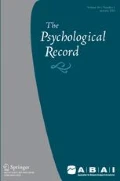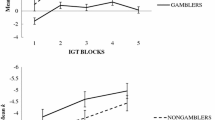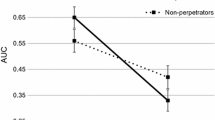Abstract
Numerous studies show that individuals with substance use and gambling problems discount delayed and probabilistic outcomes at different rates than controls. Few studies, however, have investigated the association of discounting with antisocial personality disorders (ASPD), and none have evaluated whether sex impacts these relationships. Because females with ASPD exhibit different patterns of antisocial behavior than their male counterparts, they may also differ in their decision-making tendencies. This study examined the effects of ASPD and sex on discounting in pathological gamblers. Results revealed effects of ASPD, and an interaction between ASPD and sex, on probability discounting rates. None of these variables, however, were related to delay discounting. Females with ASPD highly preferred probabilistic outcomes, suggesting that female gamblers with ASPD are particularly impulsive when it comes to probabilistic rewards. Greater understanding of sex differences in ASPD might help guide the selection of more effective sex-specific prevention and treatment programs.


Similar content being viewed by others
References
Alegria, A. A., Blanco, C., Petry, N. M., Skodol, A. E., Liu, S.-M., Grant, B., et al. (2013). Sex differences in antisocial personality disorder: results from the National Epidemiological Survey on Alcohol and Related Conditions. Personality Disorders: Theory, Research, and Treatment. doi:10.1037/a0031681.
American Psychiatric Association. (2000). Diagnostic and statistical manual of mental disorders (4th ed., Text Revision). Washington, DC: Author.
Andrade, L. F., & Petry, N. M. (2012). Delay and probability discounting in pathological gamblers with and without a history of substance use problems. Psychopharmacology, 219, 491–499.
Andrade, L. F., Alessi, S. M., & Petry, N. M. (2013). The effects of alcohol problems and smoking on delay discounting in individuals with gambling problems. Journal of Psychoactive Drugs, 45(3), 241–248.
Bickel, W. K., & Marsch, L. A. (2001). Toward a behavioral economic understanding of drug dependence: delay discounting processes. Addiction, 96, 73–86.
Blanco, C., Hasin, D. S., Petry, N., Stinson, F. S., & Grant, B. F. (2006). Sex differences in subclinical and DSM-IV pathological gambling: results from the national epidemiologic survey on alcohol and related conditions. Psychological Medicine, 36(07), 943–953.
Bondolfi, G., Osiek, C., & Ferrero, F. (2000). Prevalence estimates of pathological gambling in Switzerland. Acta Psychiatrica Scandinavica, 101, 473–475.
Cale, E. M., & Lilienfeld, S. O. (2002). Sex differences in psychopathy and antisocial personality disorder: a review and integration. Clinical Psychology Review, 22, 1179–1207.
Cottler, L. B., Price, R. K., Compton, W. M., & Magers, D. E. (1995). Subtypes of adult antisocial behavior among drug abusers. The Journal of Nervous and Mental Disease, 183, 154–161.
de Wit, H., Flory, J. D., Acheson, A., McCloskey, M., & Manuck, S. B. (2007). IQ and nonplanning impulsivity are independently associated with delay discounting in middle-aged adults. Personality and Individual Differences, 42, 111–121.
Fals-Stewart, W., O'Farrell, T. J., Freitas, T. T., McFarlin, S. K., & Rutigliano, P. (2000). The timeline follow-back reports of psychoactive substance use by drug-abusing patients: psychometric properties. Journal of Consultation and Clinical Psychology, 68, 134–144.
Goldstein, R., Powers, S. I., McCusker, J., Mundt, K. A., Lewis, B. F., & Bigelow, C. (1996). Gender differences in manifestations of antisocial personality disorder among residential drug abuse treatment clients. Drug and Alcohol Dependence, 41, 35–45.
Goldstein, R. B., Compton, W. M., Pulay, A. J., Ruan, W., Pickering, R. P., Stinson, F. S., et al. (2007). Antisocial behavioral syndromes and DSM-IV drug use disorders in the United States: results from the national epidemiologic survey on alcohol and related conditions. Drug and Alcohol Dependence, 90, 145–158.
Grant, J. E., & Kim, S. (2002). Gender differences in pathological gamblers seeking medication treatment. Comprehensive Psychiatry, 43, 56–62.
Grant, J. E., Steinberg, M. A., Kim, S. W., Rounsaville, B. J., & Potenza, M. N. (2004a). Preliminary validity and reliability testing of a structured clinical interview for pathological gambling. Psychiatry Research, 128, 79–88.
Grant, B. F., Stinson, F. S., Dawson, D. A., Chou, S. P., Ruan, W. J., & Pickering, R. P. (2004b). Co-occurrence of 12-month alcohol and drug use disorders and personality disorders in the United States: results from the national epidemiologic survey on alcohol and related conditions. Archives of General Psychiatry, 61, 361–368.
Green, L., & Myerson, J. (2010). Experimental and correlational analyses of delay and probability discounting. In G. J. Madden & W. K. Bickel (Eds.), Impulsivity: The behavioral and neurological science of discounting (pp. 67–92). Washington, DC: American Psychological Association.
Hesselbrock, M. N., Meyer, R. E., & Keener, J. J. (1985). Psychopathology in hospitalized alcoholics. Archives of General Psychiatry, 42, 1050–1055.
Holt, D. D., Green, M., & Myerson, J. (2003). Is discounting impulsive? Evidence from temporal and probability discounting in gambling and non-gambling college students. Behavioural Processes, 64, 355–367.
Kessler, R., Hwang, I., LaBrie, R., Petukhova, M., Sampson, N., Winters, K., et al. (2008). DSM-IV pathological gambling in the national comorbidity survey replication. Psychological Medicine: A Journal of Research in Psychiatry and the Allied Sciences, 38, 1351–1360.
Kirby, K. N., & Marakovic, N. N. (1996). Delay-discounting probabilistic rewards: rates decrease as amounts increase. Psychonomic Bulletin and Review, 3, 100–104.
Kirby, K. N., Petry, N. M., & Bickel, W. K. (1999). Heroin addicts have higher discount rates for delayed rewards than non-drug-using controls. Journal of Experimental Psychology: General, 128, 78–87.
Leonhard, C., Mulvey, K., Gastfriend, D., & Shwartz, M. (2000). The addiction severity index: a field study of internal consistency and validity. Journal of Substance Abuse Treatment, 18, 129–135.
Lesieur, H. R., & Blume, S. B. (1987). The South Oaks Gambling Screen (The SOGS): a new instrument for the identification of pathological gamblers. American Journal of Psychiatry, 144, 1184–1188.
Lesieur, H. R., & Blume, S. B. (1991). Evaluation of patients treated for pathological gambling in a combined alcohol, substance abuse, and pathological gambling treatment unit using the Addiction Severity Index. British Journal of Addiction, 86, 1017–1028.
Lesieur, H. R., & Blume, S. B. (1992). Modifying the Addiction Severity Index for use with pathological gamblers. American Journal of Addiction, 1, 240–247.
Lewis, C. E., & Bucholz, K. K. (1991). Alcoholism, antisocial behavior and family history. British Journal of Addiction, 86, 177–194.
MacKillop, J., Amlung, M. T., Few, L. R., Ray, L. A., Sweet, L. H., & Munafò, M. R. (2011). Delayed reward discounting and addictive behavior: a meta-analysis. Psychopharmacology, 216, 305–321.
Madden, G. J., Petry, N. M., & Johnson, P. S. (2009). Pathological gamblers discount probabilistic rewards less steeply than matched controls. Experimental and Clinical Psychopharmacology, 17, 283–290.
Mazur, J. E. (1984). Tests of an equivalence rule for fixed and variable reinforcer delays. Journal of Experimental Psychology: Animal Behavior Processes, 19, 426–436.
McLellan, A. T., Luborsky, L., Cacciola, J., Griffith, J. E., Evans, F., Barr, H. L., et al. (1985). New data from the Addiction Severity Index: reliability and validity in three centers. Journal of Nervous and Mental Disease, 173, 412–423.
Mikulich-Gilbertson, S. K., Salomonsen-Sautel, S., Sakai, J. T., & Booth, R. E. (2007). Gender similarities and differences in antisocial behavioral syndromes among injection drug users. The American Journal on Addictions, 16(5), 372–382.
Mitchell, S. H. (1999). Measures of impulsivity in cigarette smokers and non-smokers. Psychopharmacology, 146, 455–464.
Moeller, F., Dougherty, D. M., Barratt, E. S., Schmitz, J. M., Swann, A. C., & Grabowski, J. (2001). The impact of impulsivity on cocaine use and retention in treatment. Journal of Substance Abuse Treatment, 21, 193–198.
Myerson, J., Green, L., Hanson, J. S., Holt, D. D., & Estle, S. J. (2003). Discounting delayed and probabilistic rewards: processes and traits. Journal of Economic Psychology, 24, 619–635.
Ohmura, Y., Takahashi, T., & Kitamura, N. (2005). Discounting delayed and probabilistic monetary gains and losses by smokers of cigarettes. Psychopharmacology, 182, 508–515.
Overall, J. E., & Spiegel, D. K. (1969). Concerning least squares analysis of experimental data. Psychological Bulletin, 72, 311–322.
Patkar, A. A., Murray, H. W., Mannelli, P., Gottheil, E., Weinstein, S. P., & Vergare, M. J. (2004). Pre-treatment measures of impulsivity, aggression and sensation seeking are associated with treatment outcome for African-American cocaine-dependent patients. Journal of Addictive Diseases, 23, 109–122.
Petry, N. M. (2001). Pathological gamblers, with and without substance abuse disorders, discount delayed rewards at high rates. Journal of Abnormal Psychology, 110, 482–487.
Petry, N. M. (2002). Discounting of delayed rewards in substance abusers: relationship to antisocial personality disorder. Psychopharmacology, 162, 425–432.
Petry, N. M. (2003). Validity of a gambling scale for the Addiction Severity Index. Journal of Nervous and Mental Disease, 191, 399–407.
Petry, N. M. (2007). Gambling and substance use disorders: current status and future directions. American Journal on Addictions, 16, 1–9.
Petry, N. M. (2012). Discounting of probabilistic rewards is associated with gambling abstinence in treatment-seeking pathological gamblers. Journal of Abnormal Psychology, 121, 151–159.
Petry, N. M., & Casarella, T. (1999). Excessive discounting of delayed rewards in substance abusers with gambling problems. Drug and Alcohol Dependence, 56, 25–32.
Petry, N. M., Kirby, K. N., & Kranzler, H. R. (2002). Effects of gender and family history of alcohol dependence on a behavioral task of impulsivity in healthy subjects. Journal of Studies on Alcohol, 63, 83–90.
Petry, N. M., Stinson, F. S., & Grant, B. F. (2005). Comorbidity of DSM-IV pathological gambling and other psychiatric disorders: results from the national epidemiologic survey on alcohol and related conditions. Journal of Clinical Psychiatry, 66, 564–574.
Petry, N. M., Ammerman, Y., Bohl, J., Doersch, A., Heather, G., Kadden, R., et al. (2006). Cognitive-behavioral therapy for pathological gamblers. Journal of Consulting and Clinical Psychology, 74, 555–567.
Rachlin, H., Raineri, A., & Cross, D. (1991). Subjective probability and delay. Journal of the Experimental Analysis of Behavior, 55, 233–244.
Reynolds, B. (2006). A review of delay-discounting research with humans: relations to drug use and gambling. Behavioural Pharmacology, 17, 651–667.
Reynolds, B., Richards, J. B., Horn, K., & Karraker, K. (2004). Delay discounting and probability discounting as related to cigarette smoking status in adults. Behavioural Processes, 65, 35–42.
Sargeant, M. N., Bornovalova, M. A., Trotman, A. J. M., Fishman, S., & Lejuez, C. W. (2012). Facets of impulsivity in the relationship between antisocial personality and abstinence. Addictive Behaviors, 37(3), 293–298.
Shead, N. W., Callan, M. J., & Hodgins, D. C. (2008). Probability discounting among gamblers: differences across problem gambling severity and affect-regulation expectancies. Personality and Individual Differences, 45, 536–541.
Sobell, L. C., & Sobell, M. B. (1992). Timeline follow-back: A technique for assessing self-reported alcohol consumption. In R. Z. Litten & J. P. Allen (Eds.), Measuring alcohol consumption (pp. 41–71). Totowa: Humana Press.
Stinchfield, R. (2002). Reliability, validity, and classification accuracy of the South Oaks Gambling Screen (SOGS). Addictive Behaviors, 27, 1–19.
Swann, A. C., Lijffijt, M., Lane, S. D., Steinberg, J. L., & Moeller, F. G. (2009). Trait impulsivity and response inhibition in antisocial personality disorder. Journal of Psychiatric Research, 43, 1057–1063.
Weinstock, J., Whelan, J. P., & Meyers, A. W. (2004). Behavioral assessment of gambling: an application of the timeline follow-back method. Psychological Assessment, 16, 72–80.
Acknowledgements
This research and preparation of this report were supported in part by NIH grants: P30-DA023918, R01-DA027615, P50-DA09241, P60-AA03510, R01-HD075630, R01-DA021567, R01-MH60417, and T32-AA07290.
Author information
Authors and Affiliations
Corresponding author
Rights and permissions
About this article
Cite this article
Andrade, L.F., Riven, L. & Petry, N.M. Associations Between Antisocial Personality Disorder and Sex on Discounting Rates. Psychol Rec 64, 639–646 (2014). https://doi.org/10.1007/s40732-014-0085-0
Published:
Issue Date:
DOI: https://doi.org/10.1007/s40732-014-0085-0




